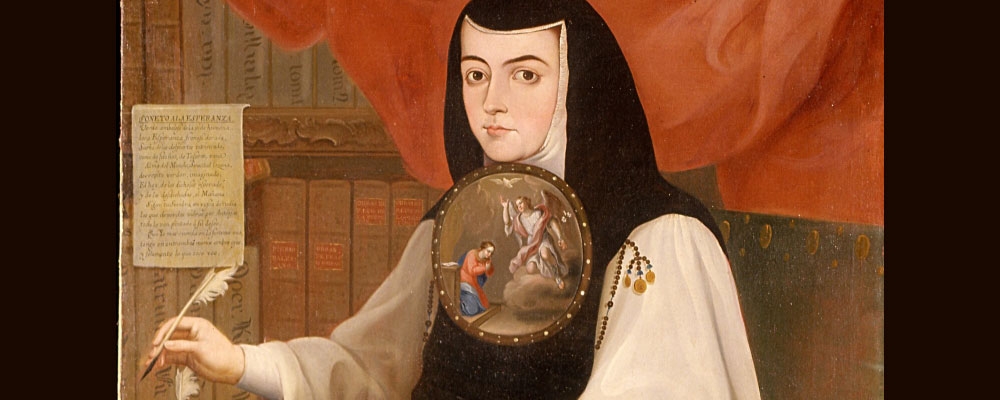
We present the biography of Sor Juana Inés de la Cruz, the highest figure of Mexican letters. Discover more about his life and work.
Sor Juana Inés de la Cruz was born in the hacienda of San Miguel Nepantla, State of Mexico, on November 12, 1648. Her name, before taking the habit, was Juana de Asbaje y Ramírez since she was the natural daughter of the creole Isabel Ramírez de Santillana and the vizcaíno Pedro Manuel de Asbaje.
As a child, Sor Juana grew up with her maternal grandfather Pedro Ramírez, at the hacienda Panoayan. His genius manifested from an early age: having studied only the first letters in Amecameca.
At the age of three Sor Juana already knew how to read, at seven she asked to be sent to study at the University and at eight she wrote a loa for the Corpus’ party.
In 1656, at the death of his grandfather, his mother sent Sor Juana to the capital to live at the house of her sister, María Ramírez, wife of the wealthy Juan de Mata.
There, Sor Juana Inés studied Latin “in twenty lessons” with the bachelor Martín de Olivas, only those few were enough to master this language, which is demonstrated in the mastery of several of his works, especially in the Christmas carols, which contain Latin verses.
Sor Juana tells in her “Letter answer to Sor Filotea de la Cruzleía”, she studied hard, and her obstinacy was such to learn that she came to use the self-coercive method of cutting her hair to set as a deadline for her to grow again, to have already learned something she wanted.
Sor Juana read a lot throughout her life both classical Roman and Greek and Spanish authors.
In 1664 Sor Juana entered the court as a lady of the Viceroy, Leonor María Carreto, Marquise of Mancera, to whom she dedicated some sonnets named Laura. The viceroy, admired, brought together forty intellectuals of all faculties to submit it to an unparalleled examination of which, of course, came out triumphant, leaving the wise men admired for having answered with wisdom every question, argument and reply that they asked her.
Tired of courtly life, Sor Juana decided to enter a convent because, she says, “for the total denial I had to marriage was the most decent thing I could choose in terms of the security of my salvation.” First she entered the convent of San José de las Carmelitas Descalzas in 1667 but left there after three months, due to the severity of the rule and the rigor of the order. Then she entered the much more flexible order of the Jeronimas, in the convent of Santa Paula, where she finally professed on February 24, 1669.
In the convent, where she lived what she had left of life, Sister Juana Inés de la Cruz performed jobs of accountant and archivist but, more than anything, she devoted himself to study and writing. Within his bedroom – which was individual and spacious – she had more than 4,000 books, musical instruments, maps and measuring devices and had deep knowledge in astronomy, mathematics, language, philosophy, mythology, history, theology, music, painting and cooking, to name just a few of your favorite disciplines.
Unknown Mexico
Sor Juana Inés de la Cruz and her famous literary work, aun dentro del claustro, Sor Juana was constantly called to write works on request: in 1689 she was commissioned to make the Triumphal Arch upon arrival at the capital of the Marqueses de la Laguna and Condes de Paredes, a work that concluded successfully and which she titled Allegorical Neptune.
Three years later, Sor Juana won two prizes in the University Contest of the Triunfo Parténico and was constantly commissioned for Christmas festivities, in addition to the significant number of sonnets, tenths, silvas and lyres that she constantly composed.
The first book published by Sor Juana Inés de la Cruz was Inundación Castálida, which gathered a good part of her poetic work and was published in Madrid, rather than in New Spain.
For a long time, Sor Juana had no major problems in her convent life until, as Octavio Paz states, she wrote “one more letter”. That letter was published with the long title of Carta atenagórica de la madre Juana Inés de la Cruz, a religious teacher of veil and choir in the very religious convent of San Jerónimo that prints and dedicates herself to Sor Philotea de la Cruz, her studious amateur in the convent of La Santísima Trinidad de la Puebla de los Ángeles, and was a criticism of a sermon by the Portuguese Jesuit Antonio de Vieyra, a very famous theologian of the time.
This criticism had dire consequences even though its publication was in charge of the aforementioned Sor Filotea, who was none other than the bishop of Puebla, Fernández de Santa Cruz, who, finally, finally reconvened her and advised her to devote herself to less profane matters and Most Holy The whole affair ended in which Sor Juana was forced to get rid of her library, her musical and mathematical instruments and forced to dedicate herself exclusively to the convent.
Sister Juana died on April 17, 1695, infected by the epidemic that hit the convent of Santa Paula.

